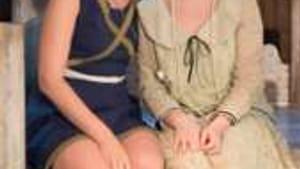Stay in the Loop
BSR publishes on a weekly schedule, with an email newsletter every Wednesday and Thursday morning. There’s no paywall, and subscribing is always free.
A whimsical survival course
Philip Dawkins's "Failure: A Love Story'

Life is a journey, death a destination. Failure: A Love Story is an enchanting little poetic fable in which the Fail family negotiates its short but happy trip. As the title suggests, none of the characters actually achieves the desired consummation; but they do enjoy some romance during their brief earthly sojourn.
The time is 1900, 1928 and several years before, after and in between. The scene is The Fail Clockworks, established by an immigrant couple in 1900 near the docks in Chicago. The quirky action jumps back and forth in time like a clock gone haywire, or like life itself, lived in the present and past simultaneously (since memory colors experience).
Search for love
This is a lighthearted production, notwithstanding the premature demise of the Fail sisters Nelly (Mary Beth Shrader), Jenny June (Tabitha Allen) and Gertrude (Isa St. Clair). Only the two men in their lives survive into old age: John N. Fail (Brendan Dalton), who is washed up on shore as a baby and adopted by the Fail household; and Mortimer Mortimer (Kevin Meehan), the earnest gentleman caller who loves each of the sisters in turn.
A marvelous cast of young actors briskly directed by Azuka Theatre's resident director, Allison Heishman, double as narrators, enacting the scenes and stories of their past lives in keeping with what Heishman calls "the hidden love story of our play, the love of telling stories." Here the stories include Mortimer Mortimer's bittersweet fruitless search for love, the affecting loneliness of his "almost brother-in-law," John N. Fail, Nelly's silly but fetching girlishness, and Jenny June's boldly optimistic goal of swimming across the rough and freezing waters.
River of time
Other important if inanimate characters occupy this household as well: a few birds, a snake named Moses and a dog called Pal, each ingeniously made from fabrics. A scarf and a jacket take on many guises. A long and wide sheath of blue cloth assumes the principal role of the river of time that sweeps away lives and years. (It's actually Lake Michigan in its earliest form.)
Music too, emanates from an old Victrola, and some vintage songs, like "Let Me Call You Sweetheart," add nostalgia for past eras.
Since the passage of time is the recurrent theme, clocks and timepieces abound in Lindsay Meyer's minimal but effective set. If Philip Dawkins's script contains a few too many time-related puns, they are easily forgiven. The lighting by Robin Stamey, the costumes by Amanda Sharp and the sound by Toby Pettit all contribute to a memorable evening whose theme— storytelling as a key to surviving human tragedy— resonates long after the play ends.
The time is 1900, 1928 and several years before, after and in between. The scene is The Fail Clockworks, established by an immigrant couple in 1900 near the docks in Chicago. The quirky action jumps back and forth in time like a clock gone haywire, or like life itself, lived in the present and past simultaneously (since memory colors experience).
Search for love
This is a lighthearted production, notwithstanding the premature demise of the Fail sisters Nelly (Mary Beth Shrader), Jenny June (Tabitha Allen) and Gertrude (Isa St. Clair). Only the two men in their lives survive into old age: John N. Fail (Brendan Dalton), who is washed up on shore as a baby and adopted by the Fail household; and Mortimer Mortimer (Kevin Meehan), the earnest gentleman caller who loves each of the sisters in turn.
A marvelous cast of young actors briskly directed by Azuka Theatre's resident director, Allison Heishman, double as narrators, enacting the scenes and stories of their past lives in keeping with what Heishman calls "the hidden love story of our play, the love of telling stories." Here the stories include Mortimer Mortimer's bittersweet fruitless search for love, the affecting loneliness of his "almost brother-in-law," John N. Fail, Nelly's silly but fetching girlishness, and Jenny June's boldly optimistic goal of swimming across the rough and freezing waters.
River of time
Other important if inanimate characters occupy this household as well: a few birds, a snake named Moses and a dog called Pal, each ingeniously made from fabrics. A scarf and a jacket take on many guises. A long and wide sheath of blue cloth assumes the principal role of the river of time that sweeps away lives and years. (It's actually Lake Michigan in its earliest form.)
Music too, emanates from an old Victrola, and some vintage songs, like "Let Me Call You Sweetheart," add nostalgia for past eras.
Since the passage of time is the recurrent theme, clocks and timepieces abound in Lindsay Meyer's minimal but effective set. If Philip Dawkins's script contains a few too many time-related puns, they are easily forgiven. The lighting by Robin Stamey, the costumes by Amanda Sharp and the sound by Toby Pettit all contribute to a memorable evening whose theme— storytelling as a key to surviving human tragedy— resonates long after the play ends.
What, When, Where
Failure: A Love Story. By Philip Dawkins; Allison Heishman directed. Through May 26, 2013 at Azuka Theatre, 1636 Sansom St. (215) 563-1100 or www.azukatheatre.org.
Sign up for our newsletter
All of the week's new articles, all in one place. Sign up for the free weekly BSR newsletters, and don't miss a conversation.